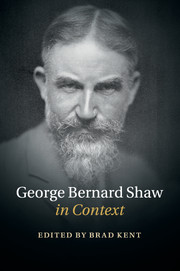Book contents
- Frontmatter
- Dedication
- Contents
- List of illustrations
- Notes on contributors
- Preface
- Acknowledgements
- A Chronology of Shaw's Works
- List of abbreviations
- PART I PEOPLE AND PLACES
- PART II THEATRE
- 7 The Abbey Theatre
- 8 Actors and actresses
- 9 The Court Theatre
- 10 Fabian drama
- 11 Farcical comedy
- 12 History plays
- 13 Melodrama
- 14 The New Drama
- PART III WRITING AND THE ARTS
- PART IV POLITICS
- PART V CULTURE AND SOCIETY
- PART VI RECEPTION AND AFTERLIFE
- Further reading
- Index
- References
13 - Melodrama
from PART II - THEATRE
Published online by Cambridge University Press: 05 October 2015
- Frontmatter
- Dedication
- Contents
- List of illustrations
- Notes on contributors
- Preface
- Acknowledgements
- A Chronology of Shaw's Works
- List of abbreviations
- PART I PEOPLE AND PLACES
- PART II THEATRE
- 7 The Abbey Theatre
- 8 Actors and actresses
- 9 The Court Theatre
- 10 Fabian drama
- 11 Farcical comedy
- 12 History plays
- 13 Melodrama
- 14 The New Drama
- PART III WRITING AND THE ARTS
- PART IV POLITICS
- PART V CULTURE AND SOCIETY
- PART VI RECEPTION AND AFTERLIFE
- Further reading
- Index
- References
Summary
In March 1896, Bernard Shaw attended in his capacity as theatre reviewer a performance of a rather undistinguished nautical melodrama: True Blue, by Leonard Outram and Stewart Gordon. He conjured for his readers a notable scene in which the female villain, a lady matador, plots to eliminate her rival, who, as a stowaway, has chosen to hide herself in a ship's boiler:
Becoming acquainted, heaven knows how, with the hiding place of the heroine, she takes the stage alone, and draws a thrilling picture of her rival's impending doom. She describes her in the clammy darkness of the boiler, listening to the wild beats of her own heart. Then the sensation of wet feet, the water rising to her ankles, her knees, her waist, her neck and only by standing on tip toe, with frantic upturned face, can she breathe. One mercy alone seems vouchsafed to her: the water has lost its deadly chill. Nay, it is getting distinctly warm, even hot – hotter – scalding! Immortal powers, it is BOILING; and what was a moment ago a beautiful English girl in the exquisite budding of her beautiful womanhood, is now but a boilerful of soup, and in a moment will be but a condenser full of low-pressure steam. I must congratulate [the actress] on the courage with which she hurled this terrible word-picture at a house half white with its purgation by pity and terror, and half red with voiceless, apoplectic laughter. (OTN II: 81)
Shaw had long experience with such ‘thrilling pictures’ as this. From youthful trips to the Theatre Royal, Dublin, at which he saw the works of mid-century dramatists including Dion Boucicault, Charles Reade, and Tom Taylor, to his work as a theatre critic for the Saturday Review in the 1890s, Shaw had many opportunities to ponder melodramatic effects. So steeped was he in Victorian popular theatre that, as Martin Meisel has argued, his ‘drama of ideas was a legitimate child of that theater’.
His experience from the start was marked by the kind of doubleness noted earlier, a contrast or interplay between being helplessly gripped by theatrical effect and remaining aware of its artificiality, even absurdity.
- Type
- Chapter
- Information
- George Bernard Shaw in Context , pp. 102 - 108Publisher: Cambridge University PressPrint publication year: 2015



